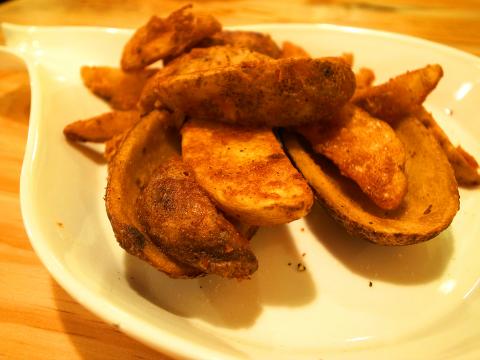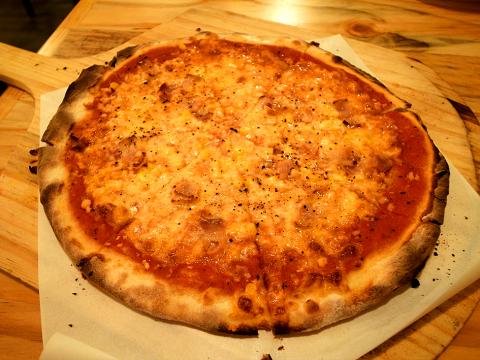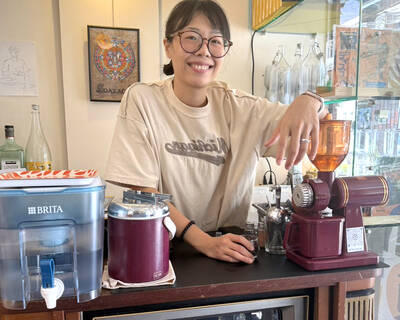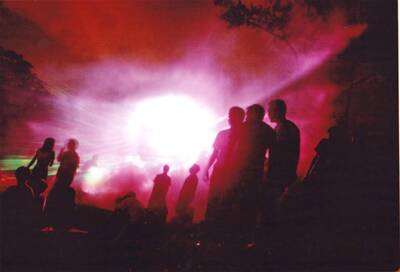A new addition to the food quarter on Ruian Street (瑞安街), where several Western-style dining establishments such as The Diner (樂子), Sterling Tavern and My Place congregate, Antico Forno sells hand-made, thin-crust pizza baked in a large oven in the restaurant’s open kitchen. So far, business seems to be brisk. On a recent Monday evening, my dining companion and I arrived at around 8:30pm, and the place was filled with mostly young, fashionably-dressed customers.
Entertainer and celebrity entrepreneur Pauline Lan (藍心湄) dined there with a group of friends, making us wonder if the pizzeria is a casual hangout spot for the famous and the beautiful.
With an ambience more up-scale than most of the restaurants nearby, the space is brightly painted in grass green and light yellow hues, while the dining tables made of iron and wood add an industrial vibe, currently in vogue. The waitstaff and the chef are all noticeably young and good-looking. But those with misgivings about the ability of the caomeizu (草莓族) — or “strawberry generation” — to stand the stresses of life, can rest assured. The service is attentive and friendly, if not brisk and efficient.

Photo: Ho Yi, Taipei Times
The food, however, is far less exciting.
The pizzeria has a limited selection of appetizers, salads and side dishes in addition to pizza. But in my opinion, the menu could benefit from an increase in quantity and improvement in quality.
We began our meal with the tomato vegetable soup (NT$100), which was overpowered by black pepper and the flavor of cheese. It was sadly lacking the vegetable’s promised sweetness. The patate al forno, or baked potatoes (NT$180), were slightly soggy but fragrant with the aroma of rosemary.

Photo: Ho Yi, Taipei Times
Fortunately, the pizzas we tried were much better. Crisp-crust lovers may want to look elsewhere, though, because Antico Forno’s rendition tends towards the buttery and chewy.
The pizzeria divides its pies into two categories: one with a thin layer of homemade tomato sauce on the crust, and one without. We ordered campagnola (NT$350) from the former group, which was topped with Italian sausage, mushrooms and corn. It looked unappetizing but tasted surprisingly good as the sourish, fruity tomato strokes a fine balance with the salty meat and sweet corn.
The diavola (NT$350), on the other hand, is not for the faint-hearted. It’s made with marinated chili, spicy Italian sausage and smoked spicy cheese.
For those looking to splurge, tartufata (NT$550) mixes truffle cream sauce with mozzarella, ricotta and Parmesan. True to its name, pazza (NT$520), or lunatic, feels like it is made by a chef gone insane, throwing everything available in the kitchen onto the pie. The hodgepodge of ingredients includes smoked chicken breast, Parma ham, salami, artichokes and egg.
One of the pizzeria’s specialties is pizza colosseo (NT$1,080), a 70cm pie big enough for five people. Patrons get to build their own oversized pie with six toppings picked from a wide selection of 20, including anchovies, salami, zucchini and artichokes. The chef makes only 10 of these giants daily.
Other pizzas on the menu include the margherita which is topped with tomato sauce, mozzarella, basil and extra virgin olive oil (NT$260) and the boscaiola (NT$350) comes with sausage, bacon, mushroom and mozzarella cheese.
Much to my disappointment, dessert pizzas are nowhere to be seen on the menu. Diners with a sweet tooth have only three Italian desserts to choose from: panna cota (NT$100), millefoglie (NT$130) and tiramisu (NT$150). Beverage choices are limited too, including Peroni (NT$130) and Super Bock (NT$150) beer.
The verdict: Antico Forno is a passable choice if you happen to be in the neighborhood and in the mood for pizza, but is probably not worth the trek when there are many other pizzerias in town offering more substantial food at wallet-friendlier prices.

Cheng Ching-hsiang (鄭青祥) turned a small triangle of concrete jammed between two old shops into a cool little bar called 9dimension. In front of the shop, a steampunk-like structure was welded by himself to serve as a booth where he prepares cocktails. “Yancheng used to be just old people,” he says, “but now young people are coming and creating the New Yancheng.” Around the corner, Yu Hsiu-jao (饒毓琇), opened Tiny Cafe. True to its name, it is the size of a cupboard and serves cold-brewed coffee. “Small shops are so special and have personality,” she says, “people come to Yancheng to find such treasures.” She

Late last month Philippines Foreign Affairs Secretary Theresa Lazaro told the Philippine Senate that the nation has sufficient funds to evacuate the nearly 170,000 Filipino residents in Taiwan, 84 percent of whom are migrant workers, in the event of war. Agencies have been exploring evacuation scenarios since early this year, she said. She also observed that since the Philippines has only limited ships, the government is consulting security agencies for alternatives. Filipinos are a distant third in overall migrant worker population. Indonesia has over 248,000 workers, followed by roughly 240,000 Vietnamese. It should be noted that there are another 170,000

In July of 1995, a group of local DJs began posting an event flyer around Taipei. It was cheaply photocopied and nearly all in English, with a hand-drawn map on the back and, on the front, a big red hand print alongside one prominent line of text, “Finally… THE PARTY.” The map led to a remote floodplain in Taipei County (now New Taipei City) just across the Tamsui River from Taipei. The organizers got permission from no one. They just drove up in a blue Taiwanese pickup truck, set up a generator, two speakers, two turntables and a mixer. They

Hannah Liao (廖宸萱) recalls the harassment she experienced on dating apps, an experience that left her frightened and disgusted. “I’ve tried some voice-based dating apps,” the 30-year-old says. “Right away, some guys would say things like, ‘Wanna talk dirty?’ or ‘Wanna suck my d**k?’” she says. Liao’s story is not unique. Ministry of Health and Welfare statistics show a more than 50 percent rise in sexual assault cases related to online encounters over the past five years. In 2023 alone, women comprised 7,698 of the 9,413 reported victims. Faced with a dating landscape that can feel more predatory than promising, many in